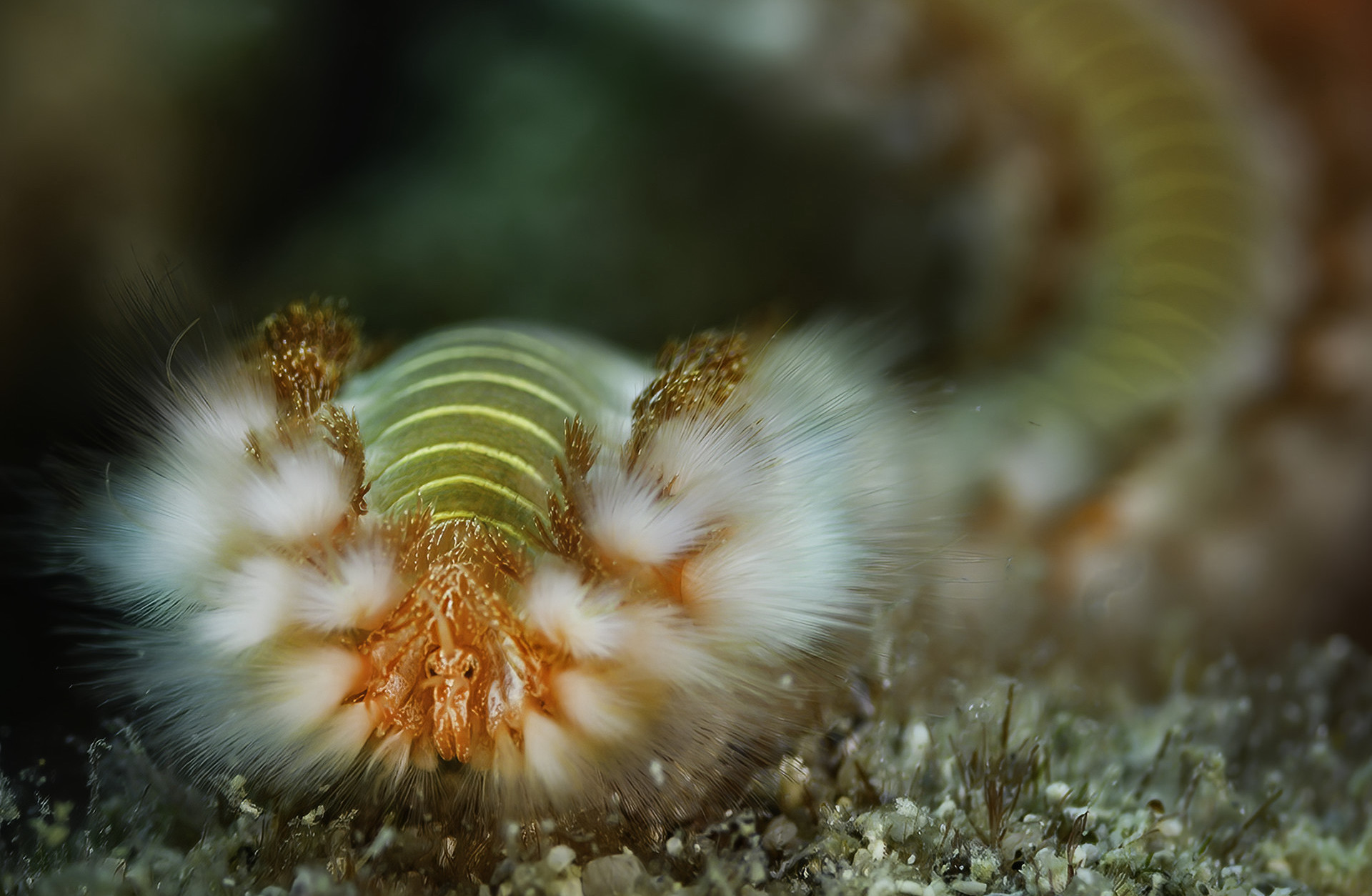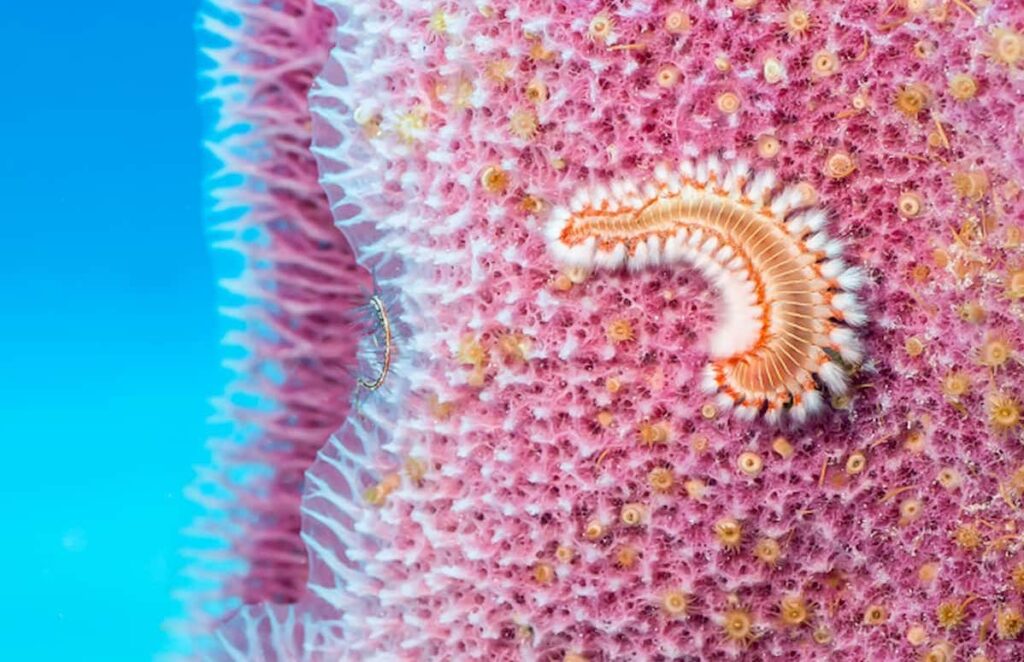What is a Bearded Fireworm?
Danger ahead! Learn about the bearded fireworm

When I think of worms, I think of going for a walk on a rainy day and seeing (and smelling) the earthworms on the sidewalk exploring their aboveground surroundings. Did you know that worms also live in our ocean? Yes, it’s true. Sometimes, I have a hard time grappling with that fact. Yes, worms do live in the ocean. Marine worms live in nearly all areas of the ocean and are a part of the larger ocean ecosystem. One type of marine worm is the bearded fireworm. It’s brightly colored, which in the wild often means—danger! Let’s learn all about the fireworm.
Bearded Fireworm
Hermodice carunculata
The bearded fireworm is a type of marine bristleworm that belongs to the Amphinomidae family.
Get Ocean Updates in Your Inbox
Sign up with your email and never miss an update.
Physical appearance
Due to their beautiful, bright red-orange coloring, fireworms are often a favorite for marine photographers. In addition to the red-orange color, fireworms can also be green, yellow or gray in color. Their shape and size look a bit like a centipede. The average size of fireworms is usually between 5-10 centimeters in length, but can reach up to 35 centimeters. Their body has between 60 and 150 separate segments.
Apart from the head and last (or end) body segment, all the other segments are completely identical. Each segment contains two paddles or “legs” called parapodia for swimming, moving around or burrowing. Each segment also has clusters of stinging white bristles and red or orange gills. The mouth is on the bottom side of their second segment. Their head, containing eyes and sensory organs, is on their first segment.
Look, but don’t touch!
Fireworms produce a stinging sensation if touched. Fireworms are covered with fine, white, brittle bristles that break if touched. They are used as a defense mechanism—easily embedding into the skin of whatever predator has come into contact with it.
The bearded fireworm “toxins” produce an intense burning irritation in the area of contact. The sting can also lead to nausea and dizziness. A painful sensation can last up to a few hours after contact.

Scientists have not yet concluded about what chemical substance is part of the stinging process. Research suggest that they are venomous and use a series of toxins to defend themselves Only time (and more research) will reveal the specifics.
Not a dragon
Fireworm is also a type of dragon from the animated movie and tv show How to Train Your Dragon. The ocean fireworm is not the same as the dragon.
Diet and reproduction
Bearded fireworms are predators. They feed on soft and hard corals, anemones and small crustaceans. They “crawl” on the tip of coral reef branches and feed on the coral tissue, removing it from the coral skeleton. You can tell where a fireworm has been dining because the coral will have a lack of color on the eaten area.
Bearded fireworms are nocturnal, which means they are active during the night and usually hidden during daytime.
Did you know?
Bearded fireworms emit bioluminescence during their mating ritual.
The bearded fireworm can reproduce through both asexual and sexual means. Asexual—their bodies divide into separate parts and regenerate to become new individuals. Sexual—they can reproduce through regular spawning—this typically occurs two to five days after a full moon. Females emit a bioluminscent glow, attracting males to the surface, where they flash their colors as well. As they move toward each other, they shed and combine their sex cells.
Habitat and range
Bearded fireworms can be found near ocean reefs and at depths of up to 500 feet. They are common throughout the tropical western Atlantic as well as the mid-Atlantic. On the eastern side they are found from Algeria to Liberia, and on the western side from the southeast coast of the United States to Guyana, including the Gulf of Mexico and the Caribbean Sea.

Don’t count on seeing the bearded fireworms at your local aquarium—since they are so hostile, they are usually not held in aquariums.
Age and population status
Bearded fireworms live between two and three years.
The conservation status of the bearded fireworm is not listed in the International Union for Conservation of Nature database. Their status and population size are unknown. Not enough research has been conducted on this species to know what threatens them.
Part of a healthy ocean ecosystem
Fireworms, like other segmented worms, help in the decomposition process. They convert organic ocean debris into carbon dioxide, which is then used by the plankton to help with photosynthesis.
How you can help coral reefs and the animals who depend on them
It’s up to all of us to help protect marine fireworms, coral reefs and all the animals living in the sea. Ocean Conservancy is working with you to protect the ocean from today’s greatest global challenges. Together, we create evidence-based solutions for a healthy ocean and the wildlife and communities that depend on it.
Please make a donation to Ocean Conservancy—give today and make a difference for the future of our ocean!